Samsung SDI Co Bundle
Can Samsung SDI Conquer the Future of Energy?
From cathode ray tubes to cutting-edge Samsung SDI Co SWOT Analysis, Samsung SDI's transformation is a case study in strategic evolution. This global leader in energy solutions and electronic materials is at the forefront of sustainable technology, but what does the future hold? Discover how Samsung SDI's ambitious growth strategy and innovative approach are reshaping the industry.
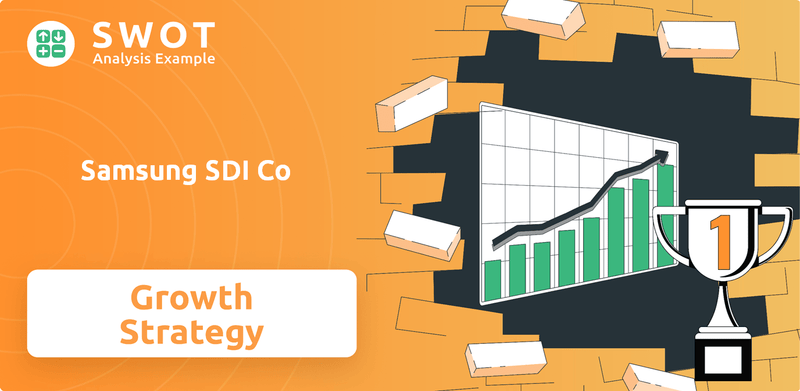
Samsung SDI's impressive financial performance, including a 2024 revenue of KRW 16.59 trillion, highlights its success in the competitive landscape. The company's focus on Battery Technology, particularly in the EV and Energy Storage Systems (ESS) sectors, positions it for significant future growth. With strategic expansion plans and a commitment to innovation, Samsung SDI is poised to capitalize on the increasing demand for sustainable energy solutions and maintain its strong position within the Samsung Electronics ecosystem.
How Is Samsung SDI Co Expanding Its Reach?
Samsung SDI's Growth Strategy for 2024-2025 is heavily focused on expanding its global footprint and diversifying its product portfolio, particularly in the battery sector. This strategic direction aims to capitalize on the growing demand for electric vehicles (EVs) and Energy Storage Systems (ESS). The company is making significant investments in both geographical expansion and technological advancements to secure its position in the rapidly evolving market.
A key element of this strategy involves strengthening its presence in the U.S. market through strategic joint ventures and partnerships. These collaborations are designed to meet the robust demand from global automotive OEMs and secure a strong foothold in the expanding North American EV market. The company's expansion plans include substantial investments in manufacturing facilities and research and development to enhance its competitive edge.
The company's initiatives are also driven by the increasing need for sustainable energy solutions and the shift towards electric mobility. Samsung SDI is strategically positioning itself to benefit from the long-term growth potential in the battery market, supported by its technological expertise and strategic partnerships. For more insights into the company's ownership structure, consider reading about Owners & Shareholders of Samsung SDI Co.
Samsung SDI is significantly expanding its presence in the U.S. through joint ventures, with early operations of its joint venture with Stellantis, StarPlus Energy, initiated in 2024. Another joint venture with General Motors is set to start production in 2027. This plant in New Carlisle, Indiana, is planned to have an initial production capacity of 27 GWh per year, expandable to 36 GWh.
The company is investing in its manufacturing facilities in Hungary, a key European production site. This involves a 323.6 billion won (approximately one billion euros) investment to renovate and expand its Göd plant. This expansion will facilitate a production changeover to stacked cell designs and increase overall capacity.
Samsung SDI is diversifying its product pipeline by investing in the development and mass production of new Battery Technology, including all-solid-state batteries and lithium iron phosphate (LFP) batteries. These advancements are crucial for meeting the evolving demands of the EV and ESS markets.
The company has secured significant contracts, such as a deal with NextEra Energy in the US for the supply of ESS equipment, valued at KRW 437 billion (US$301 million). These partnerships are vital for expanding its market presence and securing revenue streams in the ESS sector.
Samsung SDI's expansion initiatives are designed to boost its Samsung SDI's market share and Samsung SDI's battery production capacity. These initiatives are crucial for the company's long-term growth potential and its ability to compete in the evolving Samsung SDI's competitive landscape.
- Joint ventures in the U.S. to meet the growing demand from automotive OEMs.
- Expansion of manufacturing facilities in Hungary to increase production capacity.
- Investment in new battery technologies, including all-solid-state and LFP batteries.
- Strategic partnerships to expand market presence in the ESS sector.
Samsung SDI Co SWOT Analysis
- Complete SWOT Breakdown
- Fully Customizable
- Editable in Excel & Word
- Professional Formatting
- Investor-Ready Format
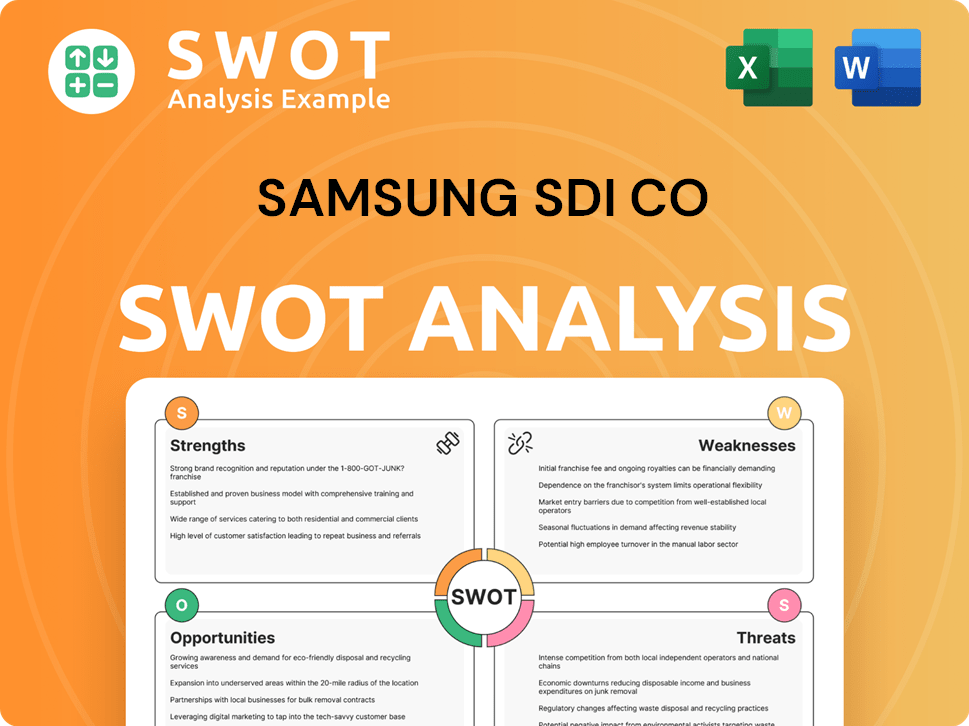
How Does Samsung SDI Co Invest in Innovation?
The cornerstone of Samsung SDI's growth strategy hinges on robust innovation, particularly in battery technology. This focus is driven by the evolving needs of the electric vehicle (EV) and energy storage systems (ESS) markets, where demand for higher energy density, enhanced safety, and faster charging times is paramount. The company's commitment to R&D is a direct response to these customer demands, ensuring it remains competitive in a rapidly changing landscape.
Customer preferences are shifting towards longer driving ranges for EVs and more efficient energy storage solutions for residential and commercial applications. Safety is another critical factor, with consumers and businesses increasingly prioritizing batteries that minimize the risk of thermal runaway and fires. Samsung SDI's innovation strategy is carefully aligned with these preferences, aiming to deliver cutting-edge battery technologies that meet and exceed these expectations.
The company’s strategic investments and technological advancements are designed to solidify its position in the market. By focusing on next-generation battery technologies and sustainable energy solutions, Samsung SDI aims to meet the growing global demand for advanced energy storage solutions.
Samsung SDI's commitment to innovation is evident in its substantial R&D investments. In 2024, the company allocated KRW 1.3 trillion to R&D efforts.
A key focus is the development of ASBs, which promise significant improvements over conventional lithium-ion batteries. Pilot production lines have been established in South Korea and Michigan, USA.
ASBs are designed to offer higher energy density, with prototypes demonstrating 500 Wh/kg, nearly double that of conventional lithium-ion batteries. This could enable EVs to travel over 600 miles on a single charge.
ASBs are expected to support ultra-fast charging, potentially in less than 9 minutes. The technology enhances safety by replacing flammable liquid electrolytes with solid ceramic materials.
Beyond ASBs, Samsung SDI is developing LFP batteries and low-cost cobalt-free batteries. These efforts aim to enhance the company's competitive edge and address diverse market needs.
Samsung SDI is also improving dry electrode manufacturing techniques. This innovation can lead to more efficient and cost-effective battery production.
In 2024, Samsung SDI held 426 battery-related patents. The company's commitment to innovation has been recognized with industry awards.
- In May 2025, Samsung SDI received two Smarter E Awards in Europe for its U8A1 uninterruptible power supply (UPS) system battery and No Thermal Propagation (No TP) technology, optimized for AI data centers.
- At CES 2025, Samsung SDI won four Innovation Awards for its PRiMX battery products, including EV batteries, ESS batteries, and cylindrical batteries. These awards highlight advancements in energy density, safety, and power.
- These awards underscore Samsung SDI's dedication to advancing battery technology and its impact on the electric vehicle market.
- These advancements contribute to Samsung SDI's long-term growth potential.
Samsung SDI Co PESTLE Analysis
- Covers All 6 PESTLE Categories
- No Research Needed – Save Hours of Work
- Built by Experts, Trusted by Consultants
- Instant Download, Ready to Use
- 100% Editable, Fully Customizable
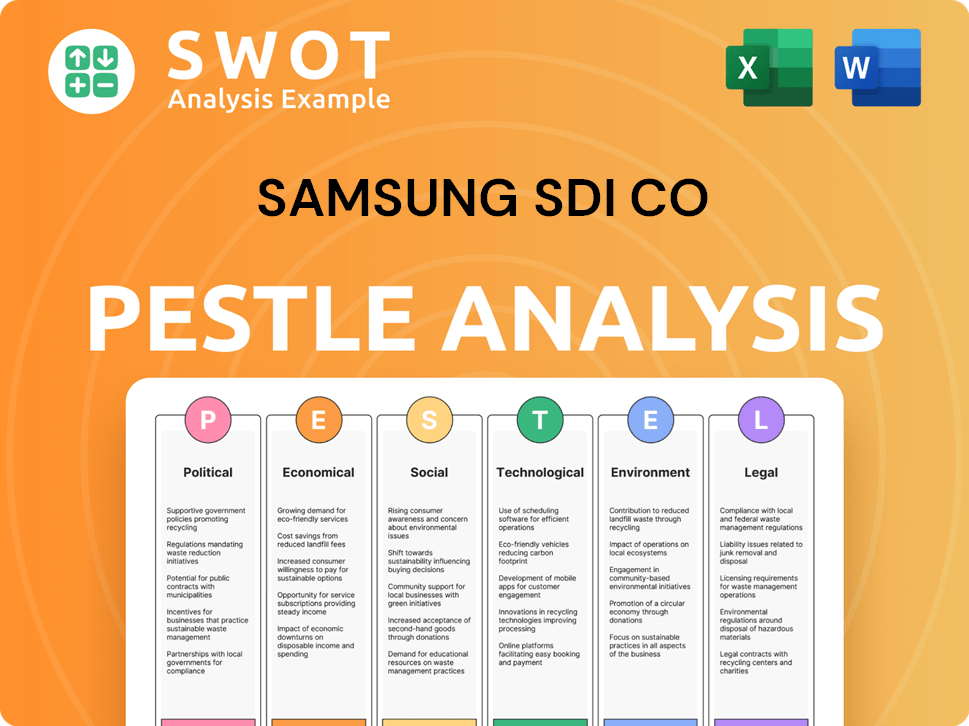
What Is Samsung SDI Co’s Growth Forecast?
In 2024, Samsung SDI faced a challenging market, reporting KRW 16.59 trillion ($11.55 billion) in revenue and an operating profit of KRW 363.3 billion. The first quarter of 2024 showed a 4% decrease in revenue to KRW 5.13 trillion ($3.7 billion) and a 29% decrease in operating profit to KRW 267.4 billion ($193 million) year-on-year. Despite these challenges, the ESS battery business achieved record-high revenue in Q4 2024, driven by demand from North American data centers.
Looking ahead, analysts forecast strong recovery and growth for Samsung SDI. Morningstar projects an 11% Compound Annual Growth Rate (CAGR) for revenue from 2024-2029, primarily due to the expansion of rechargeable batteries for automobiles. The large lithium-ion rechargeable battery segment is expected to grow by 13% annually during the same period.
The company is strategically positioning itself for future growth, particularly in the electric vehicle (EV) market. This strategic focus is supported by significant investments and partnerships designed to enhance its battery production capacity and market share in the rapidly evolving EV market.
Mirae Asset Securities anticipates a 70% year-on-year surge in operating profit for Samsung SDI in 2025, reaching KRW 2.8 trillion. This growth is supported by the full operation of North American lines and the Advanced Manufacturing Production Credit (AMPC).
To fund its ambitious growth strategy, Samsung SDI announced a rights offering in March 2025, aiming to raise approximately KRW 2 trillion (around $1.38 billion). These funds will be allocated for facility expansion, including its joint factory with General Motors in the U.S., expansion of its Hungary plant, and the construction of solid-state battery production lines in South Korea.
The company plans to suspend cash dividends for three years starting in 2025 to focus resources on strengthening growth engines. This strategic decision anticipates negative free cash flow due to continued facility investments.
The expansion of the large lithium-ion battery segment is projected to increase its proportion of total revenue to 73% in 2029 from 67% in 2024. The operating margin for these batteries is expected to improve to 6.9% in 2029 from 1.0% in 2024, partially due to tax rebates from the U.S. Inflation Reduction Act.
The primary drivers for Samsung SDI's future prospects include the increasing demand for Battery Technology in the automotive industry and the expansion of its Energy Storage Systems (ESS) business. Samsung SDI's focus on innovation and strategic partnerships positions it well to capitalize on these trends.
- Strong growth in the EV battery market.
- Expansion of production capacity, especially in North America.
- Strategic investments in solid-state battery technology.
- Favorable government incentives like the U.S. Inflation Reduction Act.
Samsung SDI Co Business Model Canvas
- Complete 9-Block Business Model Canvas
- Effortlessly Communicate Your Business Strategy
- Investor-Ready BMC Format
- 100% Editable and Customizable
- Clear and Structured Layout
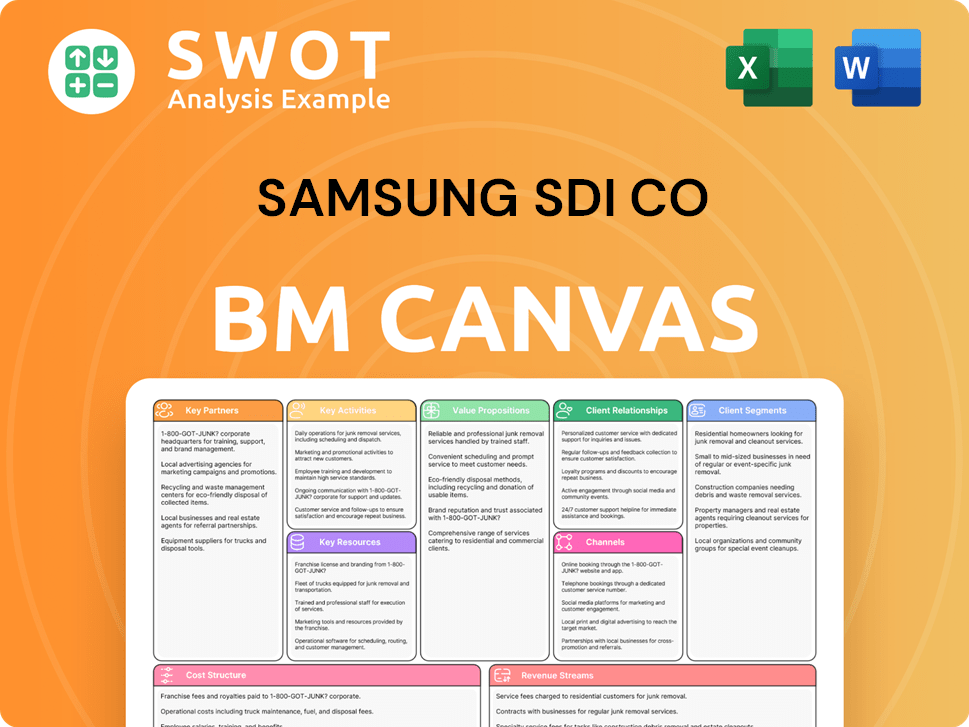
What Risks Could Slow Samsung SDI Co’s Growth?
Navigating the path of Samsung SDI's (a subsidiary of Samsung Electronics) Growth Strategy and achieving promising Future Prospects involves addressing several significant risks and obstacles. The company faces intense competition, especially from Chinese battery manufacturers, and must adeptly manage regulatory changes and supply chain vulnerabilities. Moreover, technological advancements and the need for continuous innovation add further layers of complexity to their operational and strategic planning.
The competitive landscape in the battery market is fierce, with Chinese companies rapidly expanding their market share. Samsung SDI must also contend with the inherent uncertainties associated with government incentives and evolving regulations. These factors necessitate a proactive approach to ensure compliance and capitalize on available opportunities while mitigating potential risks.
A recent product recall underscores the importance of rigorous quality control and risk management within Samsung SDI. Addressing these challenges requires strategic foresight, including diversification, scenario planning, and a strong commitment to technological advancement and cost optimization.
The primary challenge for Samsung SDI is the intense competition, particularly from Chinese battery manufacturers. In 2024, the combined market share of Korean battery makers, including Samsung SDI, decreased from 24% to 16%. This decline highlights the need for Samsung SDI to strengthen its market position and expand its battery production capacity.
Changes in regulations and government incentives can introduce uncertainty. Samsung SDI must navigate these changes to ensure compliance and leverage available incentives effectively. This requires a proactive approach to understanding and adapting to evolving policies, which can significantly impact the company's operations and financial performance.
Maintaining a reliable supply chain for raw materials and optimizing production processes is crucial. Disruptions in the supply chain can impact Samsung SDI's ability to meet customer demand and maintain profitability. This necessitates robust supply chain management strategies and diversification to mitigate risks.
The need for continuous investment in R&D to stay ahead of evolving Battery Technology is essential. Samsung SDI must continuously innovate to compete effectively in the rapidly changing battery market. This includes investing in advanced technologies and exploring new materials to maintain a competitive edge.
The recent recall of high-voltage battery packs highlights the importance of stringent quality control. This incident underscores the need for robust risk management frameworks to prevent product failures and maintain consumer trust. This involves constant monitoring and improvement of manufacturing processes.
Economic downturns and market volatility can impact demand and profitability. Samsung SDI must prepare for market slowdowns through diversification, scenario planning, and cost structure innovation. This includes adapting to changing market conditions and maintaining financial flexibility.
In 2024, Samsung SDI held a 4% share of the global power and Energy Storage Systems (ESS) battery shipments, ranking 7th. Chinese companies, particularly CATL, have a significant advantage, holding a 38% market share in LFP batteries. Samsung SDI is actively preparing for mass production of LFP batteries to address these challenges and improve its Samsung SDI's market share.
To address these risks, Samsung SDI is focusing on diversification, scenario planning, and technological advancements. They are also committed to cost structure innovation to improve efficiency and competitiveness. Further insights into Samsung SDI's competitive environment can be found in the Competitors Landscape of Samsung SDI Co.
Samsung SDI Co Porter's Five Forces Analysis
- Covers All 5 Competitive Forces in Detail
- Structured for Consultants, Students, and Founders
- 100% Editable in Microsoft Word & Excel
- Instant Digital Download – Use Immediately
- Compatible with Mac & PC – Fully Unlocked
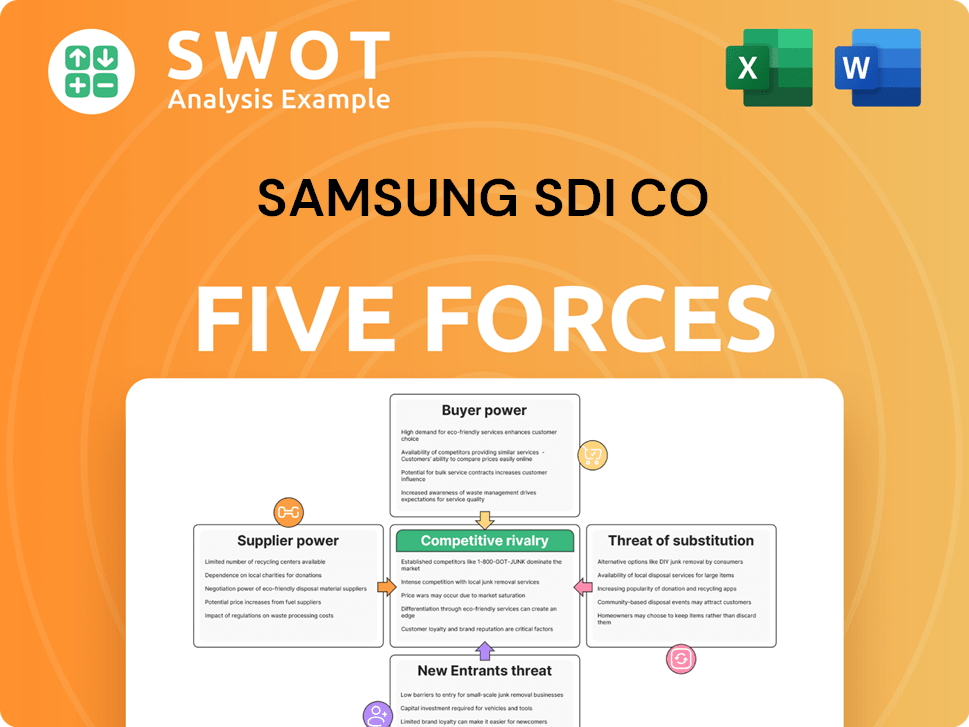
Related Blogs
- What are Mission Vision & Core Values of Samsung SDI Co Company?
- What is Competitive Landscape of Samsung SDI Co Company?
- How Does Samsung SDI Co Company Work?
- What is Sales and Marketing Strategy of Samsung SDI Co Company?
- What is Brief History of Samsung SDI Co Company?
- Who Owns Samsung SDI Co Company?
- What is Customer Demographics and Target Market of Samsung SDI Co Company?
Disclaimer
All information, articles, and product details provided on this website are for general informational and educational purposes only. We do not claim any ownership over, nor do we intend to infringe upon, any trademarks, copyrights, logos, brand names, or other intellectual property mentioned or depicted on this site. Such intellectual property remains the property of its respective owners, and any references here are made solely for identification or informational purposes, without implying any affiliation, endorsement, or partnership.
We make no representations or warranties, express or implied, regarding the accuracy, completeness, or suitability of any content or products presented. Nothing on this website should be construed as legal, tax, investment, financial, medical, or other professional advice. In addition, no part of this site—including articles or product references—constitutes a solicitation, recommendation, endorsement, advertisement, or offer to buy or sell any securities, franchises, or other financial instruments, particularly in jurisdictions where such activity would be unlawful.
All content is of a general nature and may not address the specific circumstances of any individual or entity. It is not a substitute for professional advice or services. Any actions you take based on the information provided here are strictly at your own risk. You accept full responsibility for any decisions or outcomes arising from your use of this website and agree to release us from any liability in connection with your use of, or reliance upon, the content or products found herein.